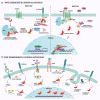β-catenin inhibitors in cancer therapeutics: intricacies and way forward
- PMID: 37655825
- PMCID: PMC10478749
- DOI: 10.1080/21655979.2023.2251696
β-catenin inhibitors in cancer therapeutics: intricacies and way forward
Abstract
β-catenin is an evolutionary conserved, quintessential, multifaceted protein that plays vital roles in cellular homeostasis, embryonic development, organogenesis, stem cell maintenance, cell proliferation, migration, differentiation, apoptosis, and pathogenesis of various human diseases including cancer. β-catenin manifests both signaling and adhesive features. It acts as a pivotal player in intracellular signaling as a component of versatile WNT signaling cascade involved in embryonic development, homeostasis as well as in carcinogenesis. It is also involved in Ca2+ dependent cell adhesion via interaction with E-cadherin at the adherens junctions. Aberrant β-catenin expression and its nuclear accumulation promote the transcription of various oncogenes including c-Myc and cyclinD1, thereby contributing to tumor initiation, development, and progression. β-catenin's expression is closely regulated at various levels including its stability, sub-cellular localization, as well as transcriptional activity. Understanding the molecular mechanisms of regulation of β-catenin and its atypical expression will provide researchers not only the novel insights into the pathogenesis and progression of cancer but also will help in deciphering new therapeutic avenues. In the present review, we have summarized the dual functions of β-catenin, its role in signaling, associated mutations as well as its role in carcinogenesis and tumor progression of various cancers. Additionally, we have discussed the challenges associated with targeting β-catenin molecule with the presently available drugs and suggested the possible way forward in designing new therapeutic alternatives against this oncogene.
Keywords: WNT signaling; cancer; mutations; natural compounds; β-catenin; β-catenin inhibitors.
Conflict of interest statement
Chandra Prakash Prasad serves as Editorial Board Member of the Bioengineered journal. This does not alter the authors’ adherence to all guidelines for publication in the journal.
Figures




References
Publication types
MeSH terms
Substances
LinkOut - more resources
Full Text Sources
Medical
Miscellaneous
